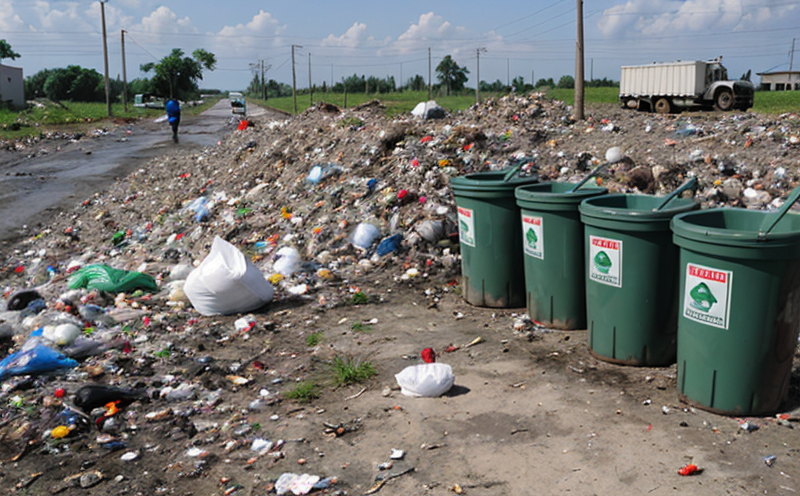ASTM E1131 Thermogravimetric Analysis of Solid Waste Test
The ASTM E1131 standard provides a methodology to determine the volatile matter (VM) content in solid waste materials through thermogravimetric analysis. This technique is crucial for understanding the composition and characteristics of various types of solid waste, aiding in environmental management, waste reduction strategies, and compliance with regulatory requirements.
The ASTM E1131 test involves heating a weighed sample in an inert atmosphere to temperatures ranging from 250°C up to 650°C. The volatile matter content is determined by the weight loss during this process. This method offers insights into the combustible components of solid waste, which can inform decisions on recycling, energy recovery, and landfill management.
The accuracy and precision of ASTM E1131 are paramount for reliable results. Proper sample preparation ensures that the test reflects the true composition of the waste material. Samples must be thoroughly dried to remove any moisture content that could interfere with the analysis. The sample should also be homogenized to ensure uniformity, which is essential for obtaining repeatable and reproducible results.
The equipment required for this test includes a thermogravimetric analyzer (TGA), an inert atmosphere furnace, and appropriate sampling accessories. The TGA measures the weight change of the sample as it undergoes heating, providing precise data on the volatile matter content. The inert atmosphere helps prevent oxidation or other reactions that could alter the results.
ASTM E1131 is widely used in environmental testing laboratories to analyze solid waste from various sources such as municipal landfills, industrial processes, and hazardous waste facilities. Understanding the volatile matter content can help in assessing the energy potential of a waste stream or identifying materials suitable for composting or incineration.
The test results are reported according to ASTM E1131 specifications, which include details on the sample preparation, heating rate, temperature range, and the weight loss observed during the analysis. These data points provide valuable information for environmental managers, waste analysts, and R&D engineers working in sectors dealing with solid waste.
The application of ASTM E1131 extends beyond just determining volatile matter content. It also helps in evaluating the stability and reactivity of different types of solid waste materials under controlled conditions. This knowledge is crucial for developing effective waste management strategies that minimize environmental impact and maximize resource recovery.
Applied Standards
The ASTM E1131 standard is part of a broader framework of testing methods aimed at ensuring the quality, safety, and environmental compatibility of solid waste materials. It aligns with international standards such as ISO 5784 for moisture content determination in compostable products and ISO 9001 for quality management systems.
Compliance with ASTM E1131 ensures that laboratories are conducting tests according to internationally recognized protocols, enhancing the credibility of their results. This standardization is particularly important in regulatory contexts where waste materials must meet specific criteria before disposal or reuse.
Scope and Methodology
The scope of ASTM E1131 encompasses the determination of volatile matter content in solid waste samples using thermogravimetric analysis. The methodology specifies precise conditions for sample preparation, heating rate, temperature range, and data interpretation.
Sample Preparation:
- Dry the sample to constant weight at 105°C ± 3°C
- Mix the sample thoroughly if it contains multiple components
- Weigh the sample accurately to within 0.0002 g
Heating Process:
- Heat the sample in an inert atmosphere (argon or nitrogen)
- Start heating at a rate of 10°C/min until reaching 300°C
- Hold at 300°C for 2 minutes, then increase the temperature to 650°C at 10°C/min
- Continue heating until complete decomposition or weight stabilization
Data Interpretation:
- Record the initial mass and final mass of the sample
- Calculate the volatile matter content as a percentage loss in mass
Use Cases and Application Examples
| Application Case | Description | ASTM E1131 Use |
|---|---|---|
| Municipal Waste Analysis | Determine the combustible content of mixed municipal waste streams to assess energy recovery potential. | Use ASTM E1131 to analyze volatile matter and identify suitable components for incineration or composting. |
| Hazardous Waste Disposal Planning | Evaluate the stability and reactivity of hazardous waste materials to ensure safe disposal practices. | Perform ASTM E1131 tests to assess the volatile matter content, which influences decisions on landfill suitability or incineration. |
| Recycling Process Optimization | Optimize recycling processes by identifying components that can be recovered for reuse or repurposing. | Analyze waste streams with ASTM E1131 to determine the potential for resource recovery and reduce environmental impact. |
| Composting Efficiency Assessment | Evaluate compostable materials in solid waste streams to improve composting efficiency and quality. | Determine volatile matter content using ASTM E1131 to ensure optimal conditions for successful composting processes. |
| Incineration Waste Sorting | Sort waste components based on their volatility, aiding in the efficient operation of incinerators. | Use ASTM E1131 tests to separate combustible from non-combustible materials for targeted processing. |
| Hazardous Waste Treatment | Treat hazardous waste by understanding its volatile matter content and choosing appropriate treatment methods. | Analyze waste with ASTM E1131 to inform decisions on chemical treatments or other environmentally friendly approaches. |
These use cases demonstrate the versatility of ASTM E1131 in various sectors dealing with solid waste management. The test results provide critical data that support informed decision-making processes, ensuring compliance and sustainability across diverse applications.





